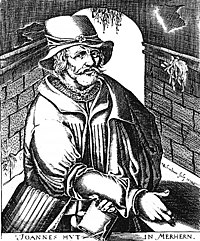Hans Hut

| Part ofa serieson |
| Anabaptism |
|---|
 |
|
|
Hans Hut(c. 1490 – 6 December 1527) was a very activeAnabaptistinsouthern GermanyandAustria.
Life
[edit]Hut was born inHainanearRömhild,SouthThuringia,and became a travelling bookseller. Hut was for some yearssacristaninBibrato the knight Hansvon Bibra(the brother of BishopLorenz von Bibra). He early came under the influence ofThomas Müntzerand, refusing to have his child baptized, was driven from the community in 1524.[1]He took part in the decisive battle of Thuringia during theGerman Peasants' Waron 15 May 1525 atBad Frankenhausen.About a week later at Bibra, Hut preached "subjects should murder all the authorities, for the opportune time has arrived." In his later years Hut distanced himself from Müntzer, saying that he (himself) "had clearly erred" and that he "had not understood him (Müntzer)."[2]After the battle he managed to flee and traveled throughout the region.
OnPentecost1526 he wasbaptizedin Augsburg byHans Denck,who had previously been baptized byBalthasar Hubmaier.Some feel that Hut and Denck taughtuniversal salvation,[3]but others question whether this was so.[4]He expected the 1528 coming of theKingdom of Godin the form of a violentapocalypticimposition of the rule ofChrist.For this reason, he curtailed his extensive missionary activity to awaitPentecost1528 and be among the144,000 elect.In addition to baptizing with water, he sealed the baptism with a sign of the cross on the forehead.
His mission activity extended from the Thuringian-French border in the north toTyrolandMoraviaand in his mission journeys he often seemed to seek former Peasants' War participants. His preaching was strongly influenced byThomas Muentzer'smysticism. Gottfried Sebaß, an expert on Hut's life and theology, calls him simply "Muentzer's heir." Among those influenced by Hut wereAugustin Bader.
In May 1527,Hans Schlafferand others joined Hut in a notable theological controversy taking place inMikulov(Czech) (in GermanNikolsburg), inMoravia,present day Czech Republic. Unfortunately, the exact subject of the debate has been lost to history, but it may have involved the question of whether or not a committed Christian could hold a job, e.g. as a soldier, in which he would be required to use violence.[5]In August 1527 Hans Hut was a key participant at theMartyrs' SynodinAugsburg,a gathering of 60 Anabaptists from the surrounding region, trying to come to a common understanding about various teachings. When the Augsburg town council learned of the meeting, they attempted to arrest the group. Hut was arrested along with the major Augsburg Anabaptists. Though the arrest did not end Hut's teaching, after a trial he and the others were sentenced to indefinite imprisonment. Hut was tortured horribly and accidentally died as a result of a fire that caused hisasphyxiationin the Augsburg prison on 6 December 1527. The next day, the authorities sentenced his dead body to death and burned him.
Hut is the author ofAusbundno. 8, “O Thou Almighty Lord and God” (O Allmächtiger Herr Gott), which is still in the hymnal used today by North AmericanAmishcongregations.[6]
Works
[edit]- Von dem geheimnis der tauf, baide des zaichens und des Wesens, ein anfang eines rechten wahrhaftigen christlichen Lebens(1527)
- Ein christlicher Underricht, wie göttliche geschrift vergleicht und geurtailt solle werden. Aus kraft des heiligen geists und zeuknus der dreitail christlichen Glaubens sambt iren verstand(1527)
References
[edit]- ^Albert Henry Newman.A manual of Church history.American Baptist Publication Society, 1903, page 161
- ^Williams, George Huntston. The Radical Reformation, 3rd Edition. Truman State Univ Press, 2000. p. 168
- ^Charles Steven Seymour.A Theodicy of Hell.Springer. 2000.
- ^Morwenna Ludlow,The Journal of Ecclesiastical History (2004), Cambridge University Press – "Why Was Hans Denck Thought to Be a Universalist?
- ^Robert Friedmann (December 1967). "The Nicolsburg Articles: A Problem of Early Anabaptist History".Church History.36(4): 391–409.doi:10.2307/3163068.JSTOR3163068.S2CID162438424.
- ^"O Allmächtiger Herr Gott".Archived fromthe originalon 2008-12-24.Retrieved2009-04-08.
Further reading
[edit]- Gottfried Sebaß:Müntzers Erbe. Werk, Leben und Theologie des Hans Hut.Gütersloh 2002.
- Werner O. Packull:Mysticism and the Early South German - Austrian Anabaptist Movement.Scottdale 1977.
- Hans-Jürgen Goertz:Die Täufer. Geschichte und Deutung.München 1988, 2. Auflage
- Gottfried Sebaß:Das Zeichen der Erwählten: zum Verständnis der Taufe bei Hans Hut- in:Umstrittenes Täufertum: 1525 - 1975; neue Forschungen(Hrsg. Hans-Jürgen Goertz), 1975, S. 138 - 164.
External links
[edit]- Hans Hut inGlobal Anabaptist Mennonite Encyclopedia Online (GAMEO)
- Complete text Ausbund no. 8 (PDF)[1][permanent dead link]
- Ausbund no. 8,O Allmächtiger Herr Gottsung in German[2]
- Ausbund no. 8, “O Thou Almighty Lord and God” (O Allmächtiger Herr Gott) sung in English[3]
